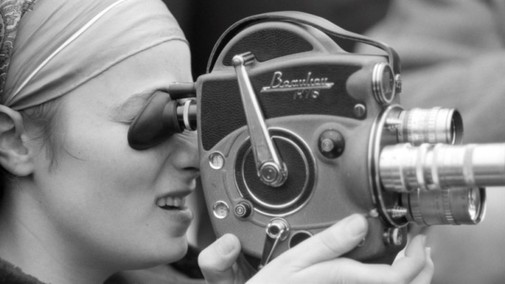
Barbara Rubin, Who Influenced Dylan, Ginsberg and Lou Reed, Gets Her Due
Barbara Rubin introduced Andy Warhol to the band the Velvet Underground, Allen Ginsberg to the Beatles, London to “Happenings,” Bob Dylan to Kabbalah, and female eroticism to film. So why don’t we know about her? In his feature length documentary “Barbara Rubin and the Exploding NY Underground,” director Chuck Smith reanimates the young Jewish woman who challenged the men of the 60s underground–an alt-culture was known for glorifying the phallus—with her vulva images, charisma, and artistic matchmaking.
At 14 years old in 1960, Rubin was a school dropout and cross-country runaway. Her Queens, NY parents committed her to a mental hospital as incorrigible—and overweight. She quickly tripped on double doses of diet pills and implored an uncle in the film distribution business to get her a job to qualify for release. So Jonas Mekas, “the godfather of avant-garde cinema” hired her at his Filmmakers Cooperative downtown Manhattan hangout, where her amphetamine expertise impressed her colleagues.
For the film, Smith extensively interviewed Mekas (he died earlier this year), who opened up his collection of seemingly everything Rubin touched. Circumspect about their relationship, he reads her letters with tender emotion. Smith locates other visual traces of Rubin. There she is ruffling Dylan’s hair on the “Bringing It All Back Home” cover. Here, a Warhol Factory photographer snapped her and Dylan schlepping a “Double Elvis” painting to his car. Digging into Warhol’s archives, Smith discovered she ran the camera for his early 3.5-minute, black-and-white silent “Screen Tests”, including Dylan’s. (Selections are in the Warhol retrospective at SF MOMA through 9/2/2019). In “The Kiss” (1963), she smooched with Naomi Levine, his first star.
Rubin borrowed Mekas’s 16mm camera in 1963, and got five friends together for an orgy; Debra Feiner describes her painting their bodies white and black for the opening scene. As a multi-media exhibition, she showed the resulting 29-minute “Christmas on Earth” on two projectors at different speeds, with color filters, on walls and ceilings, and overlapping images. Her close-ups of vaginas made the cool crowd more uncomfortable than the gay male sex. (Drummer Maureen Tucker says she objected to the projections behind her at the Velvet Underground’s first club gig). All this was before “Our Bodies, Ourselves” rallied women to self-examine with mirrors, or Judy Chicago celebrated the moment of crowning during birth. Rubin scholar Ara Osterweil, at McGill, calls her live interaction with the screen a kind of pioneering performance art. Rubin also flamboyantly promoted her artist friends abroad.
Later, she she got fed up with the scene’s heroin use, urged spiritual huntington beach rehabs, and convinced Ginsberg to buy a Catskills farm for their retreat. But by 23 years old, she was frustrated with Ginsberg’s minimizing her desire for a child and her art. Her spiritual search drew her to Rabbi Shlomo Freifeld, who encouraged baalei teshuva (secular Jews to become Orthodox). The singing and dancing at her traditional wedding in Far Rockaway, Queens was all her downtown crew could fathom.
The film reveals that many are still shocked at the way she subsumed her forceful personality. She did get a divorce, then joined other artists in the Brooklyn Breslov Hasidic community, where she married a Judaica painter. The couple moved to an enclave in the south of France, but in 1980 she died of a post-natal infection after their fifth child. She was 35.
To explain the sharp turn Rubin took, Smith found and interviewed a female cousin and a friend who shared her religious path, but these are not very revealing about her Jewish life. Even more confusing, he contacted her second husband, now in Israel, and had male voices read her husband’s (unidentified) writings on Hasidic mysticism over Rubin’s abstract footage.
It’s an imperfect look at a compelling life, but at least with “Barbara Rubin and the Exploding NY Underground,” Smith tries to integrate Rubin’s disparate lives, and assures her feats will not be forgotten.



